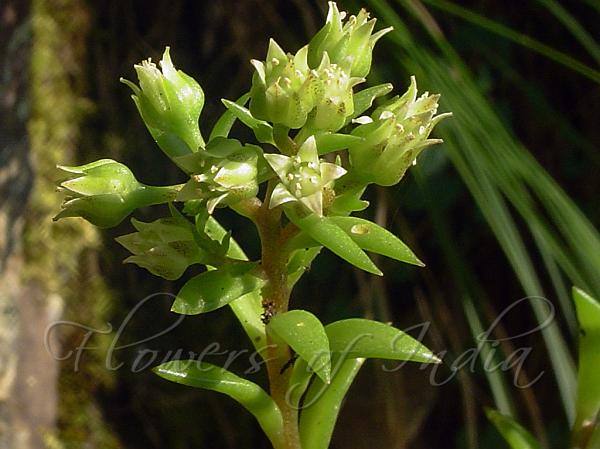|
| Indian Sedum |
|

|

| File size | 210767 |
| Original date | 9/24/14 2:42 PM |
| Resolution | 1024 x 768 |
| Flash | Flash did not fire |
| Focal length | 6.3mm |
| Exposure time | 1/250s |
| Aperture | 8.0 |
| Focus Distance | |
| Metering Mode | Spot |
| Camera make | SONY |
| Camera model | DSC-P52 |
| Sensor type |
|
|
|
|
Photo: |
Botanical name: Sinocrassula indica Family: Crassulaceae (Sedum family)
Synonyms: Sedum indicum, Sedum cavaleriense
Synonyms: Sedum indicum, Sedum cavaleriense
Indian Sedum is a biennial, hairless herb with
fibrous roots. Basal leaves are oblong-spoon-shaped, 3.5-6 x 1-1.5 cm.
Flowering stem is erect, 5-60 cm, stem leaves alternate, broadly
inverted-lanceshaped or nearly obovate, or ovate-circular, 2.5-3 x
0.4-1 cm, margin entire or distally toothed, tip obtusely rounded or
long-pointed. Flowers are borne in panicle, often corymb-like on
lateral branches generally 5-6 cm or shorter. Bracts resemble distal
stem leaves but smaller. Sepals are broadly triangular, about 2 x 1 mm,
tip somewhat pointed. Petals are red, reddish, yellow, or greenish
yellow, lanceshaped to ovate, 2.5-5.5 x about 2 mm, tip usually curled
back. Stamens are 3-4 mm. Nectar scales are quadrate, tip emarginate.
Seed-pods are apically with a recurved beak. Seeds smooth. Indian
Sedum is found in the Himalayas, from Garhwal to Bhutan, Tibet, SW
China, at altitudes of 500-4000 m.
Flowering: July-October.
| Identification credit: D.S.Rawat, Krishan Lal | Photographed in the Great Hinalayan National Park, HImachal Pradesh. |
• Is this flower misidentified? If yes,